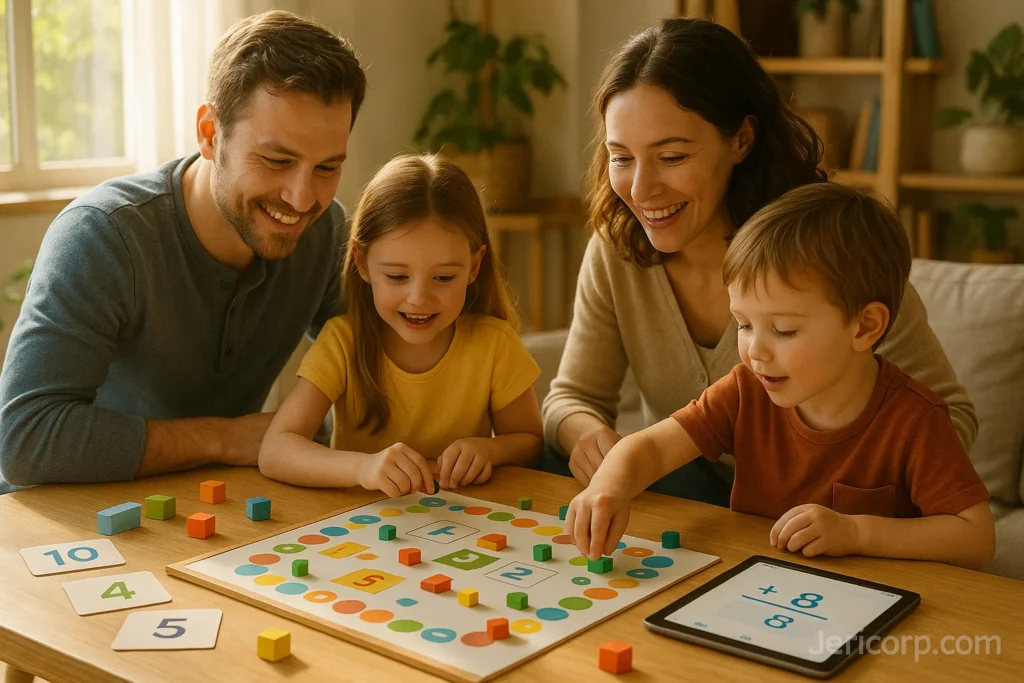Introduction: Learning Games FamParentLife in Everyday Family Life
Family life is busy, but it’s also the perfect setting for children to discover how exciting learning can be. Learning Games FamParentLife is all about blending education with play so that parents and children learn together without it feeling forced. Instead of separating “school time” from “family time,” you create moments where fun and discovery happen side by side.
When I first tried this approach, I was amazed at how quickly my children warmed to it. Reading drills often ended with sighs, but a word-building card game turned into laughter and friendly competition. They didn’t even notice they were practicing spelling and vocabulary—they were just having fun.
This guide walks you through practical ideas to make Learning Games FamParentLife a natural part of your home. You’ll find strategies, real-world examples, and age-appropriate activities that help children grow while strengthening the parent–child bond.
The Power of Play in Child Development
Play is a child’s first language, and it’s essential for healthy development. Games invite kids to explore, make mistakes, and test ideas in a setting where pressure is low and curiosity is high. That’s why Learning Games FamParentLife places play at the center of family learning. When children are engaged and moving, they remember lessons more clearly and stay motivated longer.
I’ve seen it in my own home. My youngest struggled with counting until we played a dice game where each roll meant a silly action—clapping, hopping, or dashing to touch a door. Within weeks she recognized numbers with confidence, and the excitement of the game kept her practicing without even realizing it.
Play also supports emotional growth. Waiting for a turn builds patience, losing gracefully teaches resilience, and collaborating with siblings nurtures empathy. These soft skills matter just as much as reading or math. Incorporating Learning Games FamParentLife into your routine ensures these lessons happen naturally.
Choosing the Right Learning Games FamParentLife Activities
The right game makes all the difference. Not every flashy toy or app truly teaches. Start by asking: What skill do I want to develop? Is it suited to my child’s age? Will it keep their interest? Answering these questions helps avoid the pile of barely-used games on the shelf.
- Match the game to your child’s stage. A puzzle exciting to a five-year-old may frustrate a toddler or bore a ten-year-old.
- Look for a clear learning goal. Math, reading, science exploration—be sure the game reinforces something meaningful.
- Check replay value. A flexible game that grows with your child saves money and keeps enthusiasm high.
I also let my kids help choose new activities. Their input means they’re more excited to play, which is exactly what Learning Games FamParentLife encourages—children driving their own curiosity while parents guide and join the fun.
Classic Board and Card Games That Teach
Before tablets and smartphones, families learned together around a table. Classic board and card games remain powerful tools for Learning Games FamParentLife, teaching memory, logic, and even math in a relaxed setting.
Consider Scrabble or Bananagrams for spelling and vocabulary. Chess challenges older children to think several steps ahead, sharpening problem-solving abilities. Even simple games like Uno teach color recognition and counting for younger players.
In my home, a weekly board-game night has become tradition. The laughter and conversation are as valuable as the lessons. Win or lose, everyone practices patience and cooperation—skills that reach far beyond the game table.
Outdoor Learning Games FamParentLife Style
Some of the best classrooms have no walls. Outdoor games bring movement, fresh air, and sensory experiences that indoor activities can’t match. They’re a natural fit for Learning Games FamParentLife because they combine physical activity with discovery.
A favorite in our family is the nature scavenger hunt. We create a list—find three different leaves, spot a bird, identify something red—and set a timer. Kids sharpen observation skills while learning about plants and animals. Another hit is “math tag,” where each person answers a quick addition or subtraction question before tagging the next player.
These activities help children burn energy while strengthening appreciation for the natural world. They also provide a welcome break from screens, showing that learning is everywhere, not just on a device or in a classroom.
Digital Learning Games and Apps
Technology can be an ally when used wisely. Educational apps bring math, reading, and even coding to life, making them an important part of Learning Games FamParentLife for many families. The key is choosing apps that encourage active problem-solving instead of passive tapping.
I’ve had success with apps like Prodigy for math practice and Scratch for beginner coding. These programs adjust their difficulty as children improve, keeping them challenged but not frustrated. To prevent screen fatigue, we limit each session to about twenty minutes and I stay nearby to discuss what they’re learning.
Parent involvement is vital. Playing or observing together transforms screen time into shared time, reinforcing the Learning Games FamParentLife philosophy of guided discovery.
DIY Learning Games from Everyday Items
You don’t need expensive tools to practice Learning Games FamParentLife. Many of the most effective activities cost nothing and use what’s already in your home. Creativity and a willingness to experiment are the only requirements.
One example is a flashcard treasure hunt. I hide word or number cards around the house and give clues for each location. The kids race to find them, reading or solving problems along the way. Kitchen chemistry is another favorite—mixing baking soda and vinegar turns into a lesson about reactions and measurement.
These homemade games let children help design the activity, doubling the learning value. Planning the hunt or choosing ingredients sparks curiosity and gives them a sense of ownership that store-bought games sometimes lack.
Building Social and Emotional Skills Through Play
Not all learning is academic. Games can also nurture empathy, teamwork, and conflict resolution—important goals in Learning Games FamParentLife. Cooperative board games, where everyone wins or loses together, encourage listening and joint problem-solving.
In my family, role-playing games have been especially effective. Acting out everyday challenges—resolving an argument, making a group decision—gives kids a safe way to practice social skills. We laugh a lot, but we also talk afterward about how each character felt and what could be done differently.
These experiences prepare children for real-world interactions. They learn that mistakes are part of growth and that understanding others’ feelings can be more powerful than getting their own way.
Making Learning Games FamParentLife a Daily Habit
Great ideas only work if they become routine. To make Learning Games FamParentLife part of everyday life, weave games into your schedule rather than treating them as an occasional treat.
Start by setting aside specific times. In our home, Friday evening is “family game night,” but we also slip short activities into quiet moments—waiting for dinner or during a rainy afternoon. Next, rotate games to keep interest high. A small library of choices prevents boredom. Finally, celebrate small wins. A sticker chart or simple praise motivates children to keep trying.
Over time, these habits create a household culture where curiosity is normal and learning is fun. Your child might even begin suggesting new games or creating their own, a clear sign that the Learning Games FamParentLife mindset has taken hold.
Lasting Benefits for the Whole Family
Families who embrace Learning Games FamParentLife often see results that go far beyond academics. Children gain confidence, strengthen memory, and develop a natural curiosity about the world. Parents enjoy more meaningful conversations and quality time with their kids.
In my own home, evenings are calmer and our conversations richer since we began our weekly game nights. My children talk about their favorite games with friends and even design their own. Teachers have noticed stronger problem-solving skills and greater classroom participation.
Most importantly, these games create shared memories. Years from now, your children may not recall every math fact, but they will remember the laughter, teamwork, and excitement of learning with their family.
Read More: Understanding What irobux.com Redeem Claims to Offer
Conclusion: Turning Everyday Moments into Lifelong Lessons
Learning Games FamParentLife is more than a method—it’s a mindset. By blending fun and education, you transform ordinary moments into opportunities for growth and connection. Whether you choose a classic board game, a nature scavenger hunt, a thoughtful app, or a homemade puzzle, each activity reinforces the idea that learning can be playful and rewarding.
In my own family, these games have helped my kids master new skills and, just as importantly, brought us closer together. We share laughter, solve problems side by side, and create experiences that no worksheet or lecture could match.
You don’t need a large budget or a perfect plan to start. Pick one game, set aside a little time, and join the fun. When parents and children learn side by side, education stops being a task and becomes a shared adventure—the heart of the Learning Games FamParentLife philosophy.


